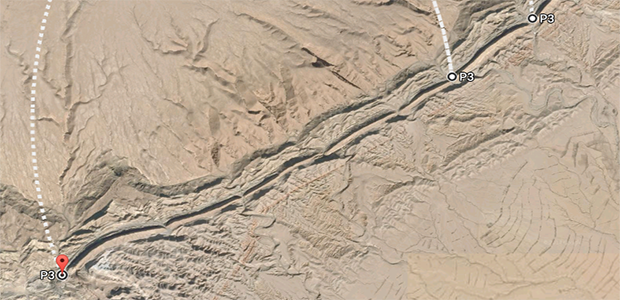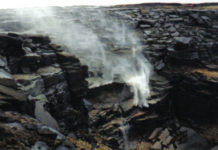Our planet used to be red hot just like the other planets before it cooled down. Water was one of the most important causes for this. Life emerged from this water and here we stand, trying to conquer the vast universe. The mysterious emergence of a lake which is being widely referred to as Gafsa Lake/Beach/LAC De GAFSA is located in the city of Gafsa, which is one of the capitals of the 24 major administrative divisions of Tunisia. Such strange origins of one of the nature’s constituents make us wonder whether these earth enveloping water bodies(oceans, rivers, lakes) started forming this way.

Tunisia is a country on the northern tip of Africa known for its dry hot conditions, with its major southern part being a desert. Otherwise devoid of any natural inland water source, it was recently delivered a surprisingly large supply of water. First spotted by the local shepherds, it has already turned into a tourist attraction and a recreational spot for the citizens. The volume of the lake is said to be about one million cubic metres over more than one hectare, having a depth ranging between 10 to 18 metres.

Though it’s discovery is being largely advertised as recent, the growth and expanse of the surrounding vegetation suggest an earlier origin. To reinforce this observation, some users on the Facebook Page dedicated to this new place, titled ‘ LAC De GAFSA ‘ also reported a 2011 picture of Google Maps showing the existence of a similar water body in that region. Also, as spotted in the Google Map view above, there are two other relatively smaller Gafsa Lake-like water bodies.
The water which was crystal turquoise blue has now turned into algae green.
Thousands are flocking to see this mysterious lake which suddenly appeared out of nowhere right in the middle of this desert. The water which was crystal turquoise blue has now turned into algae green. Scientists and researchers are skeptical about this as they fear that the water may be harmful and even carcinogenic in nature. This hasn’t stopped the locals from taking a dip into the waters.
Tunisia is well known for its phosphate mines.. So there is a high chance of phosphate poisoning
Tunisia is well known for its phosphate mines and it is also the 5th largest producer of the chemical which is used in agriculture and industry. So there is a high chance of phosphate poisoning in the people who have flocked there to take a dip, relaxing themselves near the rocks, paddling, and even scuba diving.
Another significant danger involves the way that land is being treated by industrial activities revolving around mining. One controversial method used in the mining industry is hydraulic fracturing or fracking. This involves fracturing the rock beneath the upper layers of earth by shooting high-pressure mixture of huge amounts of water mixed with dangerous chemicals. Since large quantities of water is used in the process, this water accumulates in those lower levels of the earth along with the chemicals used in the process.
If the so-called Gafsa Lake/Beach has been an earlier site for hydraulic fracturing then this source of water which has now resurfaced from those lower layers can be lethal.

The verification process to test the water safety has been delayed by the authorities.
The Guardian reported,
Ten days ago Hatef Ouigi, of Gafsa’s office of public safety, warned that the lake is dangerous and not fit for swimming in. He said this was a cautionary measure while scientists take samples and verify the water. “Depending on the results, we will take measures,” Ouigi said. Since then, there has been no further official news..
The critical nature of the situation depends upon the companies involved in mining and how thoroughly the authorities of the city study and monitor this event.

Also, phosphate mining releases selenium, which is highly toxic in nature. The toxic waste is released and it is absorbed by the plants and even the soil. This harmful release can cause selenium poisoning called selenosis in humans and its symptoms include hair loss, garlic odour in the mouth, gastrointestinal disorders and even neurological damage. In extreme cases, it may result in liver cirrhosis, pulmonary odema and death.
geologists suspect that some seismic activity may have ruptured the rocks above the water table resulting in the water seeping to the surface.
It is still not known how the lake was formed but geologists suspect that some seismic activity may have ruptured the rocks above the water table resulting in the water seeping to the surface. If this was the reason, then it poses another danger to the people swimming in the lake. The water could go back into the cracks below, dragging even the swimmers to the bottom.
The new discovery has taken many by surprise and it is quite evident on social media platforms. Many are just expressing their own theories of what may have caused the water formation while the rest are just happy with the novelty and excitement associated with this scenario. Below are some of the tweets posted by random people giving their own theory.

If this has been a totally natural occurrence, unrelated to fracking, and any other common geological processes then such lakes will surely give insights on many questions like
- origin of life,
- the current situation of the water table in Tunisia which is under constant pressure of satisfying the ever increasing mining demands,
- as well as any particular solution of getting the locals purified water.
The locals have so far enjoyed this new discovery and hope it will give them some relief from the sweltering heat of 40°c.
For now, the locals have ignored the warnings made by the officials about the various health hazards and it is just a matter of time when we will come to know whether this mysterious lake formation is really a boon for the drought-stricken country or a dreadful curse brought upon by the people and organizations involved in the regions land exploitation.
-end-




































